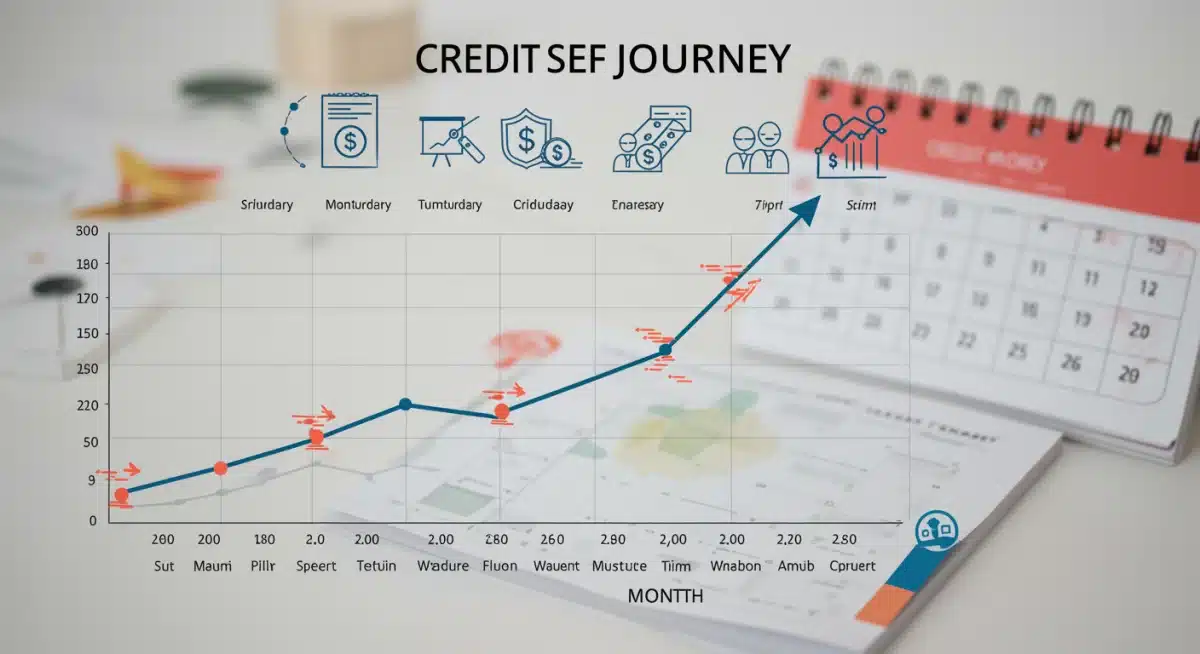Credit Score Optimization: Boost Your FICO by 50 Points

Optimizing your credit score by 50 points in six months requires a disciplined approach to payment history, credit utilization, and strategic credit account management.
Are you ready to take control of your financial future and significantly improve your borrowing power? This
credit score optimization guide delves into insider knowledge, offering actionable strategies to boost your FICO score by 50 points or more within a mere six months. Understanding and actively managing your credit is not just about getting better loan rates; it’s about unlocking financial opportunities.
Understanding your current FICO score
Before embarking on any journey to improve your FICO score, it is crucial to understand where you currently stand. Your FICO score is a three-digit number that lenders use to assess your creditworthiness. It’s a snapshot of your financial responsibility, influencing everything from mortgage rates to insurance premiums. Knowing your baseline is the first step toward strategic improvement.
Several factors contribute to your FICO score, each weighted differently. Payment history, for instance, is the most significant factor, accounting for 35% of your score. This highlights the paramount importance of paying your bills on time, every time. Missing even a single payment can have a disproportionately negative impact on your score, setting back your progress.
The five key components of your FICO score
- Payment History (35%): Timeliness of payments on all credit accounts.
- Amounts Owed (30%): How much credit you are using compared to your available credit.
- Length of Credit History (15%): How long your credit accounts have been open and active.
- New Credit (10%): Recent applications for credit and newly opened accounts.
- Credit Mix (10%): The variety of credit accounts you have, such as credit cards, installment loans, and mortgages.
Grasping these components allows you to pinpoint areas that require immediate attention. For example, if your credit utilization is high, focusing on reducing that balance will yield more significant results than simply opening a new account. A comprehensive understanding of your current credit report will serve as your roadmap for the next six months.
In essence, knowing your FICO score and its underlying components empowers you to make informed decisions. It provides a clear picture of your financial health and identifies the specific levers you can pull to initiate a positive change. This foundational knowledge is indispensable for effective credit score optimization.
Strategic payment management: the 35% solution
Payment history stands as the single most influential factor in your FICO score, making up a substantial 35%. This means that consistent, on-time payments are not merely good practice; they are absolutely critical for anyone serious about credit score optimization. Even a single late payment can significantly derail your progress, often staying on your report for up to seven years.
To ensure flawless payment history, consider setting up automatic payments for all your bills. This eliminates the risk of forgetting a due date amidst a busy schedule. Prioritize payments for credit cards and loans, as these directly impact your credit report. If you’re struggling to make full payments, always pay at least the minimum amount by the due date to avoid late fees and negative marks on your credit.
Automating your payments for peace of mind
- Set up autopay: Enroll in automatic payments directly through your bank or credit card issuer.
- Calendar reminders: Use digital calendars or apps to set payment reminders a few days before due dates.
- Review statements: Even with autopay, review your statements monthly to catch any errors or fraudulent activity.
Beyond automation, developing a robust budgeting system can prevent payment struggles altogether. By understanding your income and expenses, you can allocate funds appropriately, ensuring sufficient money is available for all your financial obligations. This proactive approach not only safeguards your credit but also promotes overall financial stability.
Addressing any past late payments is also crucial. While they remain on your report, establishing a consistent pattern of on-time payments moving forward will gradually diminish their impact. The key is to demonstrate a sustained commitment to financial responsibility. This consistent effort in strategic payment management is the bedrock of any successful credit score optimization strategy.
Mastering credit utilization: keeping balances low

Credit utilization, which accounts for 30% of your FICO score, is one of the most dynamic factors you can influence. It refers to the amount of credit you’re using compared to the total credit available to you. Lenders view high utilization as a red flag, indicating potential financial distress or over-reliance on credit. Keeping this ratio low is paramount for effective credit score optimization.
The general rule of thumb is to keep your credit utilization below 30% across all your credit cards. For optimal results, aiming for under 10% is even better. This doesn’t mean you shouldn’t use your credit cards; it means you should use them wisely and pay down balances before your statement closing date. This practice ensures that a low balance is reported to credit bureaus.
Strategies to reduce credit utilization
- Pay multiple times a month: Instead of waiting for the statement due date, make smaller payments throughout the month to keep reported balances low.
- Request credit limit increases: If your spending habits are stable and your income supports it, requesting a credit limit increase can lower your utilization ratio, provided you don’t increase your spending.
- Avoid closing old accounts: Closing an old credit card can reduce your total available credit, inadvertently increasing your utilization ratio on remaining cards.
Another effective tactic is to pay off the cards with the highest utilization first. This targeted approach can quickly bring down your overall ratio, providing a quicker boost to your score. Remember, the goal is not just to pay off debt, but to manage how much of your available credit you are actively using.
By diligently monitoring and managing your credit utilization, you can significantly impact your FICO score positively within a short timeframe. This factor offers one of the quickest ways to see tangible improvements in your credit profile, making it a cornerstone of any aggressive credit score optimization plan.
The impact of credit age and new credit inquiries
The length of your credit history, accounting for 15% of your FICO score, rewards longevity and responsible long-term credit management. The older your accounts, the better, as it demonstrates a proven track record of handling credit responsibly. This is why it’s often advised to keep older accounts open, even if you don’t use them frequently, as long as they don’t carry annual fees.
New credit, while a smaller component at 10%, can still have a notable impact. Each time you apply for new credit, a hard inquiry is placed on your credit report. A few hard inquiries within a short period can signal to lenders that you might be taking on too much debt, potentially lowering your score. It’s generally wise to space out credit applications and only apply for credit you genuinely need.
Navigating new credit and credit history
- Maintain old accounts: Keep your oldest credit accounts active, even if with minimal use, to preserve your average credit age.
- Be selective with applications: Only apply for new credit when absolutely necessary and shop for rates within a focused timeframe to bundle inquiries.
- Monitor your report: Regularly check your credit report for unauthorized inquiries, which could indicate identity theft.
Opening several new accounts simultaneously can be particularly detrimental. This not only shortens your average credit age but also introduces multiple hard inquiries, creating a double negative impact. Strategic credit score optimization involves a thoughtful approach to new credit, balancing your needs with the potential impact on your score.
Therefore, exercising patience and discipline regarding new credit and valuing the longevity of your existing accounts are crucial. These elements, though less impactful individually than payment history or utilization, collectively contribute to a robust and healthy credit profile over time, reinforcing your efforts in credit score optimization.
Diversifying your credit mix for a stronger profile
Your credit mix, making up 10% of your FICO score, reflects the variety of credit accounts you manage. Lenders appreciate seeing a healthy blend of revolving credit (like credit cards) and installment loans (like mortgages, auto loans, or student loans). This diversity indicates that you can responsibly handle different types of debt, showcasing a more versatile financial character.
While it’s not advisable to take out loans you don’t need just to improve your credit mix, if you’re already considering a major purchase that requires financing, such as a car, this can be an opportunity to diversify. Successfully managing an installment loan alongside your credit cards can positively impact this portion of your score. The key is responsible management, not simply acquiring more debt.
Examples of a healthy credit mix
- Revolving Credit: Credit cards, lines of credit.
- Installment Loans: Mortgage, auto loan, student loan, personal loan.
For those without any installment loans, a secured loan or a credit-builder loan can be a viable option. These are specifically designed to help individuals establish or improve their credit by demonstrating consistent payments on a fixed-term loan. They offer a structured way to introduce an installment account into your credit mix without significant risk.
Ultimately, a well-rounded credit portfolio signals to lenders that you are a reliable borrower capable of handling various financial commitments. This aspect of credit score optimization, while a smaller percentage, contributes to a more robust and trustworthy credit profile, enhancing your overall creditworthiness and opening more financial doors.
Monitoring and disputing: safeguarding your credit report
Regularly monitoring your credit report is not just a recommendation; it’s an essential practice for effective credit score optimization. Errors on credit reports are surprisingly common, and even a small inaccuracy can negatively impact your FICO score. By law, you are entitled to a free copy of your credit report from each of the three major bureaus (Equifax, Experian, and TransUnion) once every 12 months via AnnualCreditReport.com.
When reviewing your report, look for any discrepancies: accounts you don’t recognize, incorrect payment statuses, or outdated information. These errors can range from minor typos to significant fraudulent activities. Identifying and disputing these inaccuracies promptly is critical to maintaining an accurate and healthy credit profile.
Steps for effective credit report monitoring and dispute
- Obtain reports: Access your free credit reports from AnnualCreditReport.com.
- Review thoroughly: Scrutinize every detail for inaccuracies, including personal information, account balances, and payment history.
- Dispute errors: If you find an error, formally dispute it with the credit bureau and the information furnisher (e.g., the bank or lender).
The dispute process typically involves submitting a written letter, along with supporting documentation, to the credit bureau. They are legally obligated to investigate your claim within 30 days. If the error is confirmed, it must be removed from your report. This proactive approach ensures that your credit score accurately reflects your financial behavior, maximizing your optimization efforts.
Beyond annual checks, consider signing up for credit monitoring services, many of which are free through credit card companies or financial institutions. These services can alert you to significant changes or suspicious activity on your report in real-time, providing an added layer of protection. Vigilant monitoring and disputing are non-negotiable components of safeguarding and improving your credit score.
Accelerating your FICO boost: advanced tactics
While the fundamental strategies of payment history, utilization, and credit mix form the backbone of credit score optimization, several advanced tactics can further accelerate your FICO boost within the six-month timeframe. These often involve a deeper dive into your financial habits and leveraging specific credit tools. One such tactic is the judicious use of authorized user status.
Becoming an authorized user on a financially responsible individual’s credit card can allow their positive payment history and low utilization to reflect on your report. This is particularly beneficial for those with limited credit history or those looking for a quick, albeit temporary, boost. However, ensure the primary cardholder is indeed responsible, as their missteps could also affect you.
Advanced strategies for rapid improvement
- Secured credit cards: For those with poor credit, a secured card requires a deposit but reports to bureaus, building positive history.
- Credit-builder loans: These small installment loans are designed to help you save money and build credit simultaneously.
- Experian Boost: This free service allows you to add utility and telecom payments to your Experian credit report, potentially increasing your score.
Another often-overlooked strategy is understanding the concept of ‘credit cycling’ for utilization. Instead of waiting for your statement to close, make payments multiple times throughout the billing cycle to keep your reported balance as low as possible. This can be especially effective for cards with higher limits where you use a significant portion regularly.
Finally, if you have old, small debts that are still negatively impacting your score and are close to falling off your report, consider negotiating a ‘pay for delete’ agreement with the creditor. While not guaranteed, some creditors may agree to remove a negative mark in exchange for full payment. These advanced tactics, when applied thoughtfully, can provide that extra push needed for significant credit score optimization.
| Key Strategy | Brief Description |
|---|---|
| Payment History | Always pay bills on time; it’s 35% of your FICO score. Automate payments to avoid misses. |
| Credit Utilization | Keep balances below 30% of your credit limit; ideally under 10% for best results. |
| Credit Mix | Manage a healthy blend of revolving and installment credit to show financial versatility. |
| Monitoring & Disputes | Regularly check credit reports for errors and dispute any inaccuracies promptly. |
Frequently asked questions about credit score optimization
While results vary, aggressive credit score optimization efforts focusing on utilization and payment history can show improvements in as little as 1-2 months, with more significant boosts over 3-6 months. Consistency is key for sustained gains.
Yes, closing old credit cards can negatively impact your score by reducing your total available credit and shortening your average credit history. This can increase your credit utilization ratio on remaining cards, potentially lowering your FICO score.
Generally, paying off high-interest debt, especially credit card balances, is prioritized for credit score optimization. The interest saved often outweighs investment returns, and reduced utilization significantly boosts your FICO score. Once high-interest debt is managed, focus on savings.
Hard inquiries, which occur when you apply for new credit, can slightly lower your FICO score for a short period, typically 10% of your score impact. Soft inquiries, like checking your own credit, do not affect your score. Limit new credit applications.
The ideal credit utilization ratio is below 30% across all your revolving accounts. For maximum positive impact on your FICO score, aim to keep your utilization under 10%. Lowering this ratio is one of the fastest ways to improve your credit.
Conclusion
Embarking on a journey of credit score optimization is a powerful step towards greater financial freedom and opportunity. By diligently applying the strategies outlined—focusing on impeccable payment history, maintaining low credit utilization, understanding the nuances of credit age and new inquiries, diversifying your credit mix, and vigilantly monitoring your reports—you are well-equipped to achieve a significant FICO score increase. Remember, consistent effort and informed decision-making are your greatest allies in transforming your financial landscape and securing a brighter future. The path to a 50-point FICO boost in six months is not just a goal; it’s an attainable reality with the right insider knowledge and dedication.





